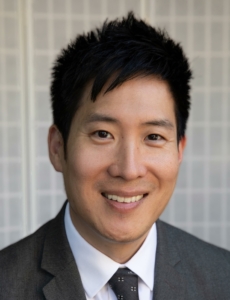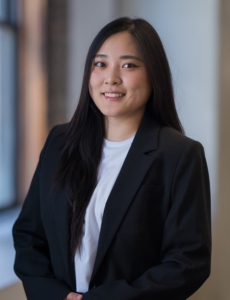A sixth-generation Altadena resident presents a community recovery roadmap after the fires Sam James and the Altadena Recovery Team meet survivors’ needs and push for policy-informed advocacy
by Peaches Chung
For Samantha “Sam” James, fire recovery and equitable rebuilding isn’t just a policy debate; it’s the reality of the community she and her family have called home for six generations.
The Eaton Fire destroyed homes across her entire extended family, including part of her own childhood home. James, a first-year master’s candidate in public policy at the UCLA Luskin School of Public Affairs, channeled her grief into action, transforming her family’s loss into a blueprint for community-driven advocacy.
It started with one simple text message to a group chat.
“I said I was going to Costco to buy hygiene supplies and asked if anyone wanted to help distribute them,” she said. That small idea turned into a full-scale supply distribution event on her cousin’s front lawn. This sparked a group effort that laid the foundation for the Altadena Recovery Team, which the founders describe as a collective of four Black women who were born and raised in the Altadena and Pasadena area, and now work to restore the spirit of their community.
“We were devastated and feeling helpless,” she said. “Being able to have a place to channel that energy that was productive, and help channel that rage, it was truly healing.”
James co-founded ART, which centers the financial, physical and mental well-being of fire survivors through distribution drives, healing spaces and on-the-ground support. As ART’s CEO, she drives grant and fundraising strategies and ensures the organization’s programs are trauma-informed and community led. Policy conversations with partners at the state level — on issues ranging from rebuilding and long-term displacement support to mental health access — are grounded in her own experience as a community member impacted by the Eaton Fire. Her commitment makes one thing clear: When communities drive their own recovery, healing is possible.
After graduating from UCLA in 2021 with a bachelor’s degree in political science, James came back in 2025 to UCLA’s MPP program with a clear purpose. After completing the highly competitive California Senate Fellowship, where she worked in state Sen. Josh Becker’s office on criminal justice reform, James went on to serve as a community engagement manager for Rising Communities, a nonprofit that works to eliminate disparities in health and social welfare in South Los Angeles. There, she trained the Los Angeles County Department of Public Health on inclusive, trauma-informed community engagement practices and worked on reform initiatives grounded in equity and justice.
“Everything I had learned was on the job,” she said. “I wanted the research background, the theoretical understanding that the MPP offered. Being back on campus has been incredible. I graduated during the pandemic, so returning now and sharing space with my cohort has been deeply meaningful.”
At UCLA, James is also a graduate student researcher with the Black Policy Project in the Ralph J. Bunche Center for African American Studies. Her research focuses on whether landlords are following the law and giving formerly incarcerated tenants a fair and lawful screening process. She also serves as the first-year representative for the Public Policy Leadership Association, strengthening student advocacy and community within the program.
She had no idea that a bill she helped draft in Becker’s office would one day directly affect her own family. James helped advance SB 1008, the Keep Families Connected Act, which made phone calls free for incarcerated people and their families. At the time, California’s prison telecom industry was worth $1.4 billion, and more than one in three families were being pushed into debt just to stay connected with incarcerated loved ones.
Years later, now with a family member experiencing incarceration, her own family is benefiting from the policy she helped pass. Seeing that impact up close reinforced her belief in community-centered policy and fueled her decision to pursue her master’s at the Luskin School.
“It was incredible to have that full-circle moment,” she says. “It showed me what’s possible when we push against the systems that keep people down in the incarceration space. It confirmed that criminal justice policy is where I want to be. After Luskin, I want to keep driving that change forward, especially as California continues to lead the way.”
James’ story recently reached a broader audience through TEDxAltadena, where she delivered a message about the unprecedented tragedies that have shaped Gen Z, and the powerful way her generation has transformed that collective rage into action.
“We’ve experienced tragedy after tragedy — 9/11, mass shootings, climate disasters, the pandemic, a mental-health crisis,” she said. “But we’re channeling that frustration into resilience and action.”
Her talk also spotlighted the origins of the Altadena Recovery Team, founded by James, Savannah Bradley, Allison Moore and Makai Ward. Together, they coordinated donations, distributed supplies, started yoga and meditation programs and pushed policy reforms, including support for mortgage relief legislation that Gov. Gavin Newsom signed into law in September. They also raised nearly $400,000 through crowdfunding and grants. James framed ART as both a recovery model and a preview of what future climate disasters will demand: localized leadership, shared power, culturally competent support and policy-informed advocacy that ensures longtime residents aren’t pushed out of the neighborhoods they helped build.
“What we know is that climate disasters are only going to intensify,” she said. “We want ART to become a resource for other communities — offering mentorship, seed funding and a roadmap so they can lead their own recovery.”
James’ advice for anyone feeling overwhelmed by the state of the world mirrors the ethos she lives by today.
“Breathe. Take space for yourself. You can only show up for others if you’re showing up for yourself,” she said. “Then get involved. Being on the ground with my community has been profoundly healing. Being in community rarely makes things worse — it almost always makes things better.”
Rooted in her love and care for her community, she is turning her rage, as she puts it, “straight into power.” And she’s just getting started.
